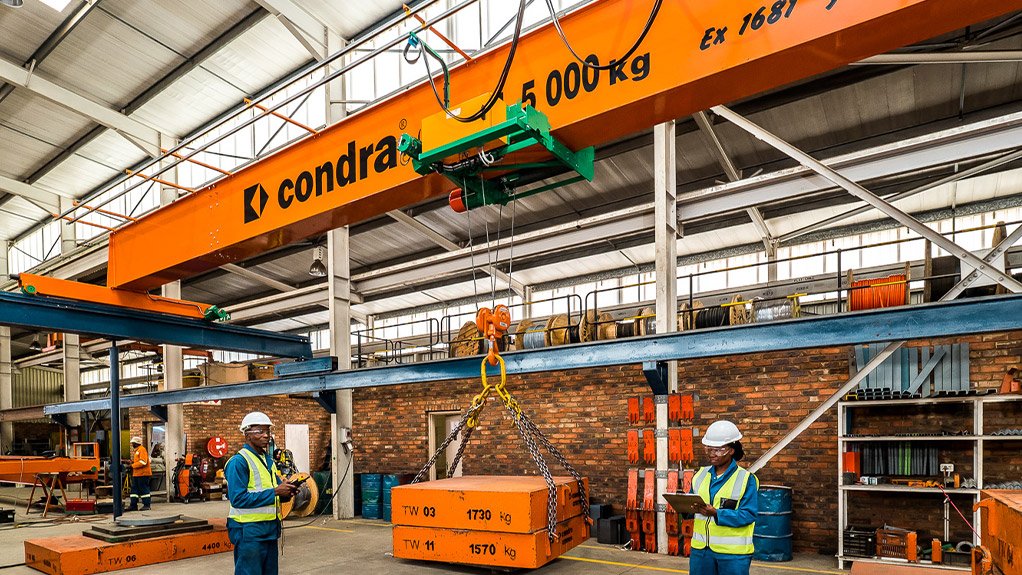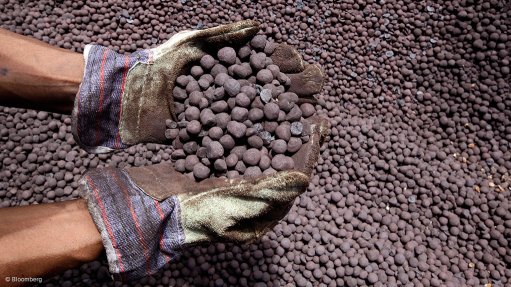Bonasika Crane Engineered Across Three Continents
This article has been supplied as a media statement and is not written by Creamer Media. It may be available only for a limited time on this website.
Today’s crane manufacturers need skills as varied as they are demanding. If growth is the goal, the company has to offer a global capability that includes a willingness to co-operate across continents and the ability to adapt product to local conditions.
An order shipped in February by South African company Condra provides a good example of just such a mind-set, with manufacture of a crane and five hoists taking place in southern Africa to the design specifications of a North American consulting firm, and installation being effected in Guyana, South America, where the Bonasika bauxite project near the Essequibo River is using the machines for general loading duties and in workshops.
Development of this open-pit bauxite mine began in June of last year.
The order placed on Condra comprised a 5-ton 13,5m-span single-girder electric overhead travelling crane and five hoists, and could be seen as straightforward were it not for the global spread of consultants, manufacturer and customer, and the specification of a precisely spliced girder to allow containerised shipping. All electric motors were also tropicalised against corrosion.
Condra’s export crane orders usually comprise hoists, end-carriages and crawls manufactured at the company’s Johannesburg works and delivered for mating to girders fabricated in the country of installation. However, the consulting engineers appointed to the Bonasika project, JDS Energy & Mining of Vancouver, Canada, specified that the box girder also be manufactured by Condra for this order.
A Condra spokesman explained that the splice for containerisation had to be sufficiently precise to deliver a completely smooth path for the wheels of the crane’s underslung hoist, in order to avoid damage to the wheels themselves and, through impact loading, to the girder and the rest of the crane structure.
The splice was executed by means of steel plates welded eccentrically to the four inside faces of the male section of the box girder, resulting in a friction grip that reinforces girder strength and integrity beyond that delivered by the splice bolts alone.
“The Condra clamped joint is almost seamless, and enables us to project a girder life in excess of 20 years,” the spokesman said.
“It sounds simpler to execute than it actually is. We have decades of experience with splicing and it has become routine for us to carry out this type of engineering, but some manufacturers struggle to get it right,” he added.
The completed crane was tested in late January, then dismantled and shipped with the five accompanying hoists to Guyana.
Crane reassembly on site took place in February, followed immediately by installation and commissioning.
Three of the five hoists included in the Bonasika order are standard 2-ton machines from Condra’s SH (short-headroom) Series, designed to make maximum use of expensive factory space – headroom as well as floor – and featuring a hoist profile some 20 percent lower than other models.
The remaining two hoists are 1-ton articulated monorail machines with high lifts of 10 and 15 metres, both of them fitted with alternating drives and modified cross-heads on the articulated crawls to allow them to negotiate bends of varying radii.
The Condra spokesman said that order execution was relatively straightforward apart from the girder splice and electrics, Bonasika’s 460V power supply being different from the more usual three-phase 400V or 525V supply, and requiring a redesign of the wiring and motor windings.
All motors were also tropicalised. Manufacture was to IP55 standard, with further protection against corrosion being provided by a tightly packed motor housing space, to eliminate as far as possible moisture ingress as the motors cool after use.
Comments
Press Office
Announcements
What's On
Subscribe to improve your user experience...
Option 1 (equivalent of R125 a month):
Receive a weekly copy of Creamer Media's Engineering News & Mining Weekly magazine
(print copy for those in South Africa and e-magazine for those outside of South Africa)
Receive daily email newsletters
Access to full search results
Access archive of magazine back copies
Access to Projects in Progress
Access to ONE Research Report of your choice in PDF format
Option 2 (equivalent of R375 a month):
All benefits from Option 1
PLUS
Access to Creamer Media's Research Channel Africa for ALL Research Reports, in PDF format, on various industrial and mining sectors
including Electricity; Water; Energy Transition; Hydrogen; Roads, Rail and Ports; Coal; Gold; Platinum; Battery Metals; etc.
Already a subscriber?
Forgotten your password?
Receive weekly copy of Creamer Media's Engineering News & Mining Weekly magazine (print copy for those in South Africa and e-magazine for those outside of South Africa)
➕
Recieve daily email newsletters
➕
Access to full search results
➕
Access archive of magazine back copies
➕
Access to Projects in Progress
➕
Access to ONE Research Report of your choice in PDF format
RESEARCH CHANNEL AFRICA
R4500 (equivalent of R375 a month)
SUBSCRIBEAll benefits from Option 1
➕
Access to Creamer Media's Research Channel Africa for ALL Research Reports on various industrial and mining sectors, in PDF format, including on:
Electricity
➕
Water
➕
Energy Transition
➕
Hydrogen
➕
Roads, Rail and Ports
➕
Coal
➕
Gold
➕
Platinum
➕
Battery Metals
➕
etc.
Receive all benefits from Option 1 or Option 2 delivered to numerous people at your company
➕
Multiple User names and Passwords for simultaneous log-ins
➕
Intranet integration access to all in your organisation





















